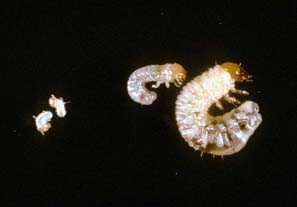Black Turfgrass Ataenius | |
|---|---|
| July 25, 2008 | |
|
Black turfgrass ataenius has two generations per year. The second generation emerges as adult beetles in July and lays eggs. This insect prefers highly maintained, highly irrigated turf, being primarily found in golf course turf. With the high rainfall this year, managers of golf courses and other fine turf areas should be watchful for high numbers of this insect.  Black turfgrass ataenius larvae appear similar to other white grubs except that they are smaller, growing only to about 1/4 inch long. For those familiar with white grubs, these appear more slender than young grubs of larger species such as Japanese beetle. They also do not have a raster pattern but have two large pads at the end of the abdomen instead. This second generation is typically controlled with the same insecticide application used for Japanese beetle and masked chafer grubs. If this application is reduced or eliminated due to smaller grub numbers, it is important to check highly irrigated areas such as greens, tees, and low-lying areas of fairways for black turfgrass ataenius. Because the grubs are smaller and donít eat as much, the threshold for control is 50 or more grubs per foot square. Imidacloprid (Merit), halofenozide (Mach 2), and trichlorfon (Dylox) are all effective against black turfgrass ataenius. | |
| Author: | Phil Nixon |
